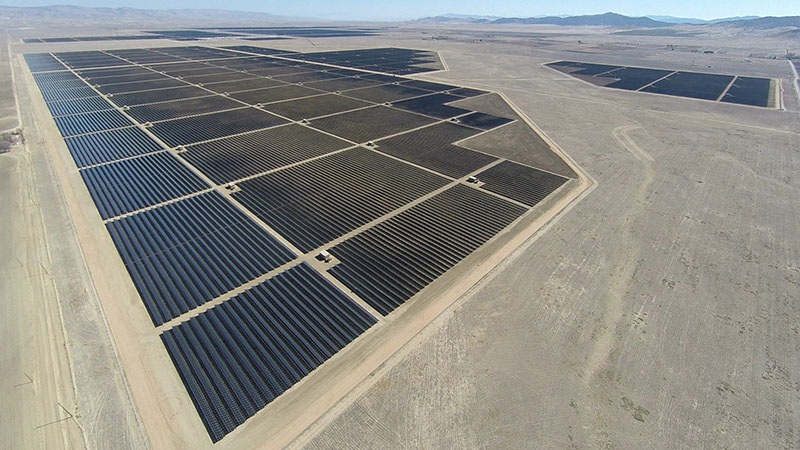 Some people have calculated that it would take 10,000 square miles of solar panels—or roughly the size of Massachusetts—to produce enough electricity to meet the demands of the United States. In the southwestern desert, where some military reservations are as large as states in New England and the sun shines more than 300 days a year, this process is already under way. Five years ago, solar plants covered less than ten square miles of land. Today it is closer to fifty square miles, an amount that’s been estimated to double in a few years time.
Some people have calculated that it would take 10,000 square miles of solar panels—or roughly the size of Massachusetts—to produce enough electricity to meet the demands of the United States. In the southwestern desert, where some military reservations are as large as states in New England and the sun shines more than 300 days a year, this process is already under way. Five years ago, solar plants covered less than ten square miles of land. Today it is closer to fifty square miles, an amount that’s been estimated to double in a few years time.
Depicted here are six plants in six different regions in the southwest where most of the solar boom is happening. The images were taken over a two-week period in late February 2014, for an exhibit and online resource produced by the Center.

Agua Caliente Solar Project, Gila River Valley, Arizona. Photo: Center for Land Use Interpretation, 2014.
Agua Caliente produces more than 250 megawatts, and is expected to produce as much as 397 megawatts when it is complete, sometime in 2014. It will have 5,200,000 photovoltaic panels, covering close to four square miles (2,400 acres). It is the westernmost of a chain of several utility-scale solar plants following the Gila River Valley, west of Phoenix, that collectively produce close to 1,000 megawatts. With expansions and new plants proposed for the region, this amount could double in a few years.
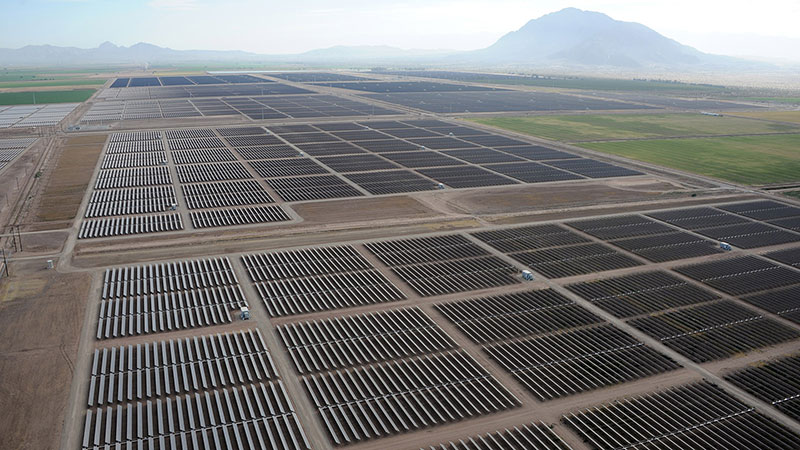
Centinela Solar Energy Project, Imperial Valley, California. Photo: Center for Land Use Interpretation, 2014.
Centinela is one of a few large photovoltaic power plants in the Imperial Valley, built in agricultural land, near the Mexican border, over the last three years. By the end of 2014, the Imperial Valley will produce around 1,000 megawatts of power, similar to what a large gas or coal-fired power plant produces, and what around 350,000 homes consume. This amount is produced only at peak output, of course, and when the sun is shining.
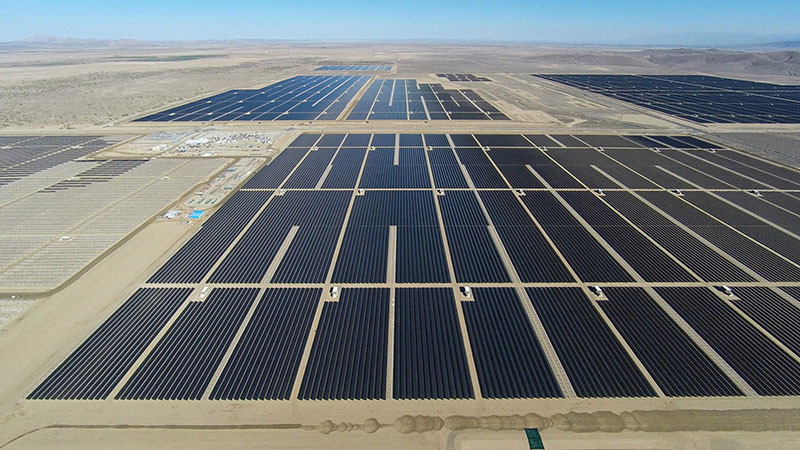
Antelope Valley Solar Ranch, Antelope Valley, California. Photo: Center for Land Use Interpretation, 2014.
The first phase of the Antelope Valley Solar Ranch went online with 150 megawatts in 2013, and is expected to produce more than 230 megawatts when it is complete, sometime in 2014. The Antelope Valley, north of Los Angeles, has a dozen utility-scale solar plants fully online or soon to be, capable of supplying more than 1,100 megawatts by the end of 2014. At the eastern end of the valley are three solar thermal plants, built in the late 1980s, which until ten years ago, were the only large utility-scale solar plants in the United States.
Topaz is the larger of two major solar power plants in the remote Carrizo Plain of California, in the Temblor Range, west of Bakersfield. Construction started in 2011, and by early 2014 it was producing 360 megawatts, more than any other solar plant in the country. It is expected to be complete by the end of 2014, with over 9 million photovoltaic panels, producing 550 megawatts, likely making it the largest solar power plant in the world. The nearby California Solar Ranch produces 250 megawatts, and was completed in 2013. Together the scattered irregular clusters of solar panels at these plants cover close to ten square miles.
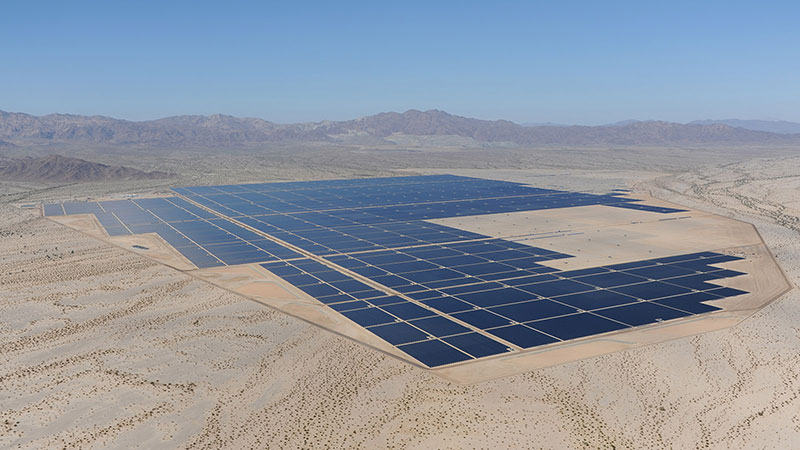
Desert Sunlight Solar Plant, Desert Center, California. Photo: Center for Land Use Interpretation, 2014.
Desert Sunlight will be one of the largest solar power plants in the world if it is built out to its expected 550 megawatts. Construction started in 2011, north of the remote Mojave town of Desert Center, and it is expected to be complete in 2015. Built by First Solar, Nextera, GE, and Sumitomo, the plant is likely to cost $2 billion, cover 3,800 acres, and use 8,800,000 photovoltaic panels. It is one of two large plants nearly completed along the Interstate 10 corridor, between Joshua Tree National Park and the Colorado River. Other large plants have been permitted for this area as well.
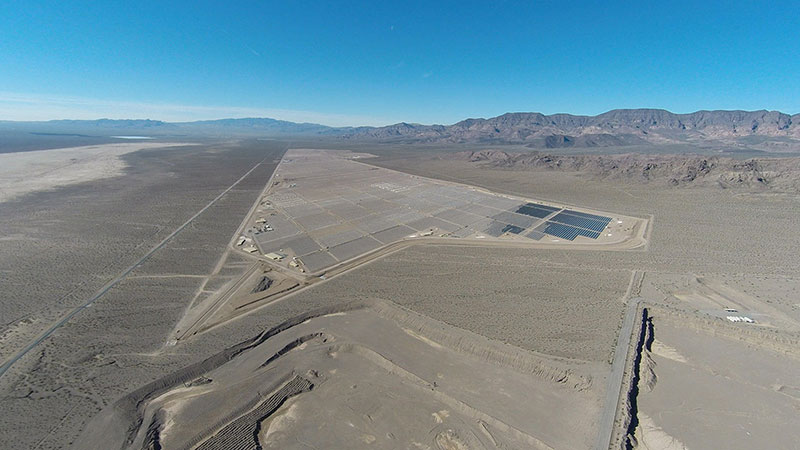
Copper Mountain 3 Solar Plant, El Dorado Valley, Nevada. Photo: Center for Land Use Interpretation, 2014.
Construction started on this 250 megawatt photovoltaic power plant in 2013, and is expected to be completed in 2015. It is located in the El Dorado Valley, south of Las Vegas, near some other smaller solar plants that are already online. This area, south of Las Vegas, has a half dozen utility-scale solar plants under construction or online, together capable of providing close to 800 megawatts. This includes the 392 megawatt Ivanpah Solar Plant, built by BrightSource, Bechtel, NRG, and Google, which opened in 2014, just over the state line in California. At least another 1,000 megawatts of solar is planned for the area.

